#native south american
Text
So apparently Swedish and Polish facial reconstructionists decided to try to recreate the famous Incan "Ice Maiden" mummy dubbed "Juanita".


Truthfully, I feel like these European reconstructionists ( do not know how to re-create Andean facial features and the results ended up... terribly uncanny. So down below, with the use of photoshop, I edited the bust with more Andean Indigenous Peruvian facial features to honor the "Ice Maiden".
My version:
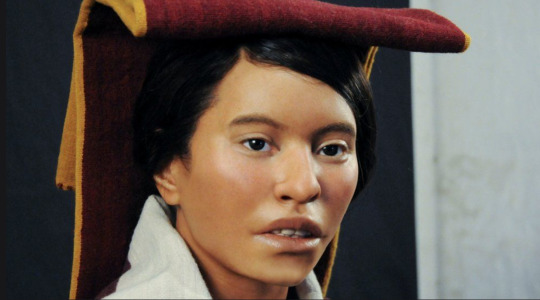
I made her brows straighter and longer, got rid of the cleft chin, gave her a down-turned mouth, broader lips (not small), I made her lips a little larger too and I made her nose longer/bigger and wider around the nasal Ala. I also broadened her nostrils a tad
and I made her under-eyes more puffy
I widened her bone structure
I emphasized her sideburns
My version (on top):
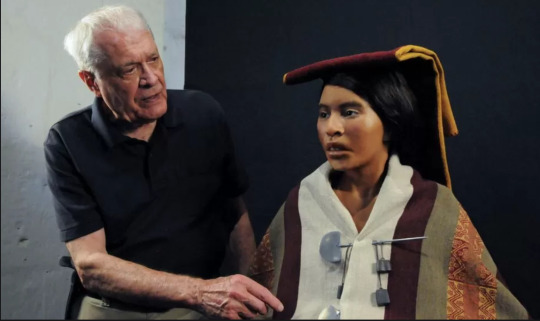
original (white euros created) below:
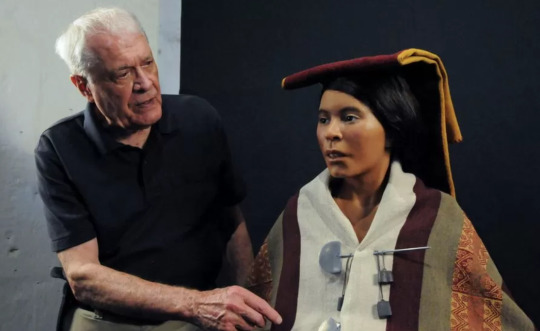
I hope that in the future, more Andean/Indigenous Peruvian facial reconstructionists have opportunities to work on revealing the faces of their kin and ancestors. We needed more andean people involved in her reconstruction.
Let me know what you think of my edits down below too!
I hope you enjoy them!
the original article can be read here:
#I took the artistic liberty to remove her cleft chin all together because i never see andeans like myself with clefts#i love a more down turned lip/mouth shape#archaeology#indigenous peruvians#native peruvian#inca#inca girl#ice maiden#facial reconstruction#my photoshops#andean history#andean pride#native south american#mujer andina#ndn tumblr#andean culture#andean textiles#andean indigenous#indigenous women#andina#andean#bipoc#indigena#pre columbian#andes#warmi#we need more ndns in science
23 notes
·
View notes
Text
TIL the female natives of Patagonia, the Fuegans, were able to withstand diving into the freezing temperature glacier water to hunt shellfish, but the men did not. They did this by covering themselves in a protective fish oil layer. It’s believed that women were in charge.
1 note
·
View note
Text

#harpo paris#native american jewelry#zuni#navajo#native american#style#vintage jewellery#silver jewelry#south western#silver#turquoise#mens style
398 notes
·
View notes
Text
Asian slaves, indigenous Americans, and identity in colonial era Mexico
The Spanish Philippines had a diverse slave population for local labor and export, including Filipino Indians [i.e. natives; indios], Muslim war captives (moros), and foreign slaves from as far away as Portuguese India.
… Upon their arrival, chino slaves [i.e. any Asian slave, not just Chinese] were absorbed by the urban economy of Mexico City, where they mainly worked as domestic servants or in textile mills (obrajes) … For their part, working in the city provided chinos with some possibilities for manumission. Chinos in domestic service were especially apt to embrace the limited opportunities available to them and to experience some social mobility. In the obrajes, chinos had few of the freedoms given to domestic servants, but they did benefit from government oversight of the industry. During official visits, chino slaves appealed for protection from overt exploitation by claiming that they were Indians (even if they were from Portuguese India). Remarkably, visiting inspectors listened to their complaints, and they often responded by liberating individual chinos under the assumption that they were indeed native vassals and could thus not be held in bondage. The overall experience of chinos in the viceroyal capital confirms the benefits of living close to the center of colonial power.
The presence of free indigenous immigrants from the Spanish Philippines in Mexico reinforced the idea that all chinos were Indians. The complex governing structure of colonial Mexico involved two republics or political communities (the república de indios and the república de españoles); this organization separated the indigenous majority from everyone else to facilitate the collection of tribute and the ministry of the Catholic Church … [N]ative immigrants from the Philippines purposely sought to confirm their membership in the Republic because corporate status provided personal advantages. They asked to be tallied in tribute rolls in Mexico to benefit from concomitant privileges, such as trading rights and legal representation through the General Indian Court. At the same time, free Filipinos were frequently confused with chino slaves - a situation that had serious consequences for Filipinos' relations with colonial institutions and enslaved individuals. Some immigrants resented having their indigenous identity questioned and sought to maintain a sense of their Indian-ness by keeping their distance from chino slaves. The majority, however, expressed solidarity with chino slaves. Filipino artisans, for example, took on chino slaves as apprentices and taught them marketable skills. Similarly, Filipino traders incorporated chinos into their own credit networks to facilitate self-purchase.
Individual chinos who were manumitted also embraced an Indian identity, regardless of whether they were from Goa, Macau, or other places in South and Southeast Asia. In this way, chinos challenged official attempts to define them solely as former slaves. Instead, they sought to join the free republic. The possibility for this kind of social integration caused widespread concern among slave owners. To defend their property rights, masters started to brand chino slaves on the face, rather than on the chest or arm as they did with Africans, in order to dissuade them from fleeing and "passing" as free Indians. This horrifying development shows that Indian communities welcomed runaway chino slaves and, by extension, that slave owners sought visible markers of their slaves' status.
Excerpt from the Introduction to “Asian Slaves in Colonial Mexico: From Chinos to Indians” (2014) by Tatiana Seijas
102 notes
·
View notes
Text

Neolicaphrium recens here might look like some sort of early horse, but this little mammal was actually something else entirely.
Known from southern South America during the late Pleistocene to early Holocene, between about 1 million and 11,000 years ago, Neolicaphrium was the last known member of the proterotheriids, a group of South American native ungulates that were only very distantly related to horses, tapirs, and rhinos. Instead these animals evolved their remarkably horse-like body plan completely independently, adapting for high-speed running with a single weight-bearing hoof on each foot.
Neolicaphrium was a mid-sized proterotheriid, standing around 45cm tall at the shoulder (~1'6"), and unlike some of its more specialized relatives it still had two small vestigial toes on each foot along with its main hoof. Tooth microwear studies suggest it had a browsing diet, mainly feeding on soft leaves, stems, and buds in its savannah woodland habitat.
It was one of the few South American native ungulates to survive through the Great American Biotic Interchange, when the formation of the Isthmus of Panama allowed North and South American animals to disperse into each other's native ranges. While many of its relatives had already gone extinct in the wake of the massive ecological changes this caused, Neolicaphrium seems to have been enough of a generalist to hold on, living alongside a fairly modern-looking selection of northern immigrant mammals such as deer, peccaries, tapirs, foxes, jaguars… and also actual horses.
Some of the earliest human inhabitants of South America would have seen Neolicaphirum alive before its extinction. We don't know whether they had any direct impact on its disappearance – but since the horses it lived alongside were hunted by humans and also went extinct, it's possible that a combination of shifting climate and hunting pressure pushed the last of the little not-horses over the edge, too.
———
NixIllustration.com | Tumblr | Twitter | Patreon
#science illustration#paleontology#paleoart#palaeoblr#neolicaphrium#proterotheriidae#litopterna#meridiungulata#south american native ungulates#panperissodactyla#ungulate#mammal#art#convergent evolution#not-horse#a phony pony#quaternary extinction
479 notes
·
View notes
Text
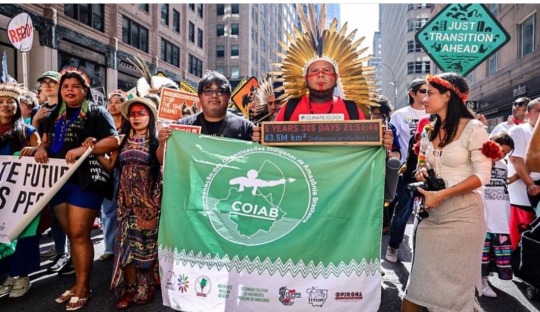

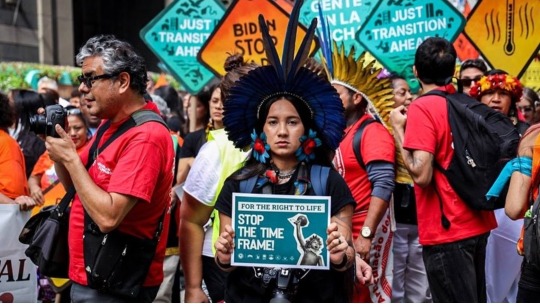
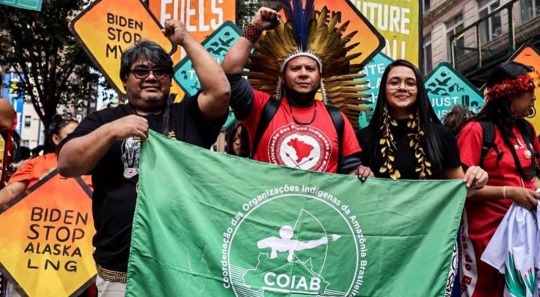
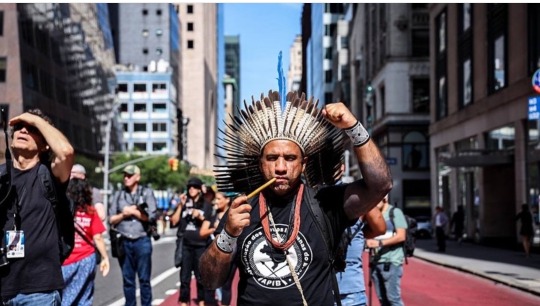

"Trial scheduled for September 20th at the Supreme Federal Court may determine the future of Indigenous Lands in Brazilian territory and be crucial for the global climate. The indigenous movement is mobilizing across Brazil, and an indigenous delegation from Apib is in New York during Climate Week to strengthen the international mobilization campaign in defense of Indigenous Lands rights."
"We are on the land, and the land is within us. If the land dies, we as indigenous peoples die."
The Articulação dos Povos Indígenas do Brasil (Articulation of Indigenous Peoples of Brazil — APIB) is calling for nationwide mobilizations this week and participating in the New York Climate Week to alert the world to the risks of the Supreme Federal Court (STF) judgment scheduled for September 20th. The court will vote on the legitimacy of the legal concept known as the "Temporal Framework," advocated by the Brazilian agribusiness, which could reevaluate Indigenous Land demarcations and impact global climate crisis mitigation efforts.
The Temporal Framework suggests that only indigenous people who can prove they were living on the land in 1988, the same year the Federal Constitution was created, should have rights to the land. This disregards the forced displacements of hundreds of indigenous groups who could only reclaim their traditional lands after Brazil's redemocratization in the late 1980s.
This week, the 15th edition of Climate Week is taking place in New York from September 17th to 24th, alongside the 78th Session of the United Nations General Assembly from September 19th to 23rd, which will feature a speech by President Lula during its opening. A delegation of 10 indigenous leaders is in New York to participate in Climate Week's activities. The international mobilization's goal is to emphasize to the world that the Temporal Framework is a threat to the lives of Brazil's indigenous peoples and could exacerbate the climate crisis, as Indigenous Lands serve as a reservoir of life on the planet.
Apib and its regional organizations are reinforcing mobilizations in territories, cities, and Brasília against the Temporal Framework on September 20th. The goal is to monitor the trial and strengthen the next steps of the indigenous movement's fight. The organizations within Apib mobilized over 220 protests in 21 states, including the Federal District, between May and June.
Five Supreme Federal Court (STF) justices are yet to vote in the trial. The current tally stands at four votes against the Temporal Framework thesis and two in favor. Justices Edson Fachin, Alexandre de Moraes, Cristiano Zanin, and Luís Roberto Barroso have expressed opposition to the agribusiness-backed thesis, while the only favorable votes came from justices appointed by former President Jair Bolsonaro, André Mendonça, and Nunes Marques.
On the same day as the STF vote, the Brazilian Senate attempts to put the Temporal Framework into law. The ruralist caucus in Congress seeks to create tension with the Brazilian judiciary since there is a possibility that the STF may invalidate the Temporal Framework thesis.
In addition to the Temporal Framework, Bill 2903 proposes other setbacks to the rights of indigenous peoples, such as the construction of highways and hydroelectric plants in indigenous territories without free, prior, and informed consent from affected communities. The proposal also aims to allow farmers to enter production contracts with indigenous people, violating the rights of indigenous peoples to the exclusive use of demarcated territories.
While some falsely claim that "there is too much land for too few indigenous people in Brazil," Apib counters that there is too much land for too few farmers and that agribusiness promotes the illegal invasion of indigenous lands. The entity asserts,
"There is no solution to the climate crisis without guaranteeing the rights of indigenous peoples and the demarcation of their territories."
Currently, nearly half of Brazil's land is in the hands of rural producers. Of the total land in the country, 41% corresponds to rural properties, 13.7% to indigenous lands, and 45.2% to other purposes, according to data published in the Official Gazette of the Union. Indigenous Lands are a guarantee of life for indigenous peoples and for all of humanity, which depends on the climate's future.
"As worsening climate crisis unfolds, many will be marked in history as accomplices to the new colonialism threatening the survival of us, indigenous peoples who inhabit the vast territory known as Brazil, and the future of all humanity because there is no solution to the climate crisis without the involvement of indigenous peoples," emphasizes Dinamam Tuxá.
Key activities of Apib during the 15th edition of Climate Week from September 17th to 24th:
On September 17th, Apib participated in the Climate Week march through the streets of New York in support of the Fight Fossil Fuel Strike. The indigenous delegation from Apib denounced the threat posed by the Temporal Framework thesis, highlighted the indigenous emergency situation concerning extractive industries and agribusiness that lead to multiple instances of violence in our territories. Additionally, as part of the Climate Week agenda, it's worth noting that Apib's executive coordinators Kleber Karipuna, Dinamam Tuxá, and other members of the indigenous delegation will participate in a talk on September 19th titled "FCLP: Rights, Participation, and Benefits for Indigenous Peoples and Local Communities in Forest Climate Financing," organized by the Forest and Climate Leaders Partnership. On September 22nd, a portion of the delegation will be present at a dialogue co-organized with H.E Razan Al Mubarak, the current president of the International Union for Conservation of Nature, to assess progress in the COP28 agenda with the aim of collectively identifying meaningful and respectful ways for Indigenous Peoples to engage in the COP.
About APIB
The Articulation of Indigenous Peoples of Brazil (Apib) is a nationally recognized entity within the indigenous movement in Brazil, created from the grassroots up. It brings together seven regional indigenous organizations (Apoinme, ArpinSudeste, ArpinSul, Aty Guasu, Conselho Terena, Coaib, and Comissão Guarani Yvyrupa) and was founded with the purpose of strengthening the unity of our peoples, fostering coordination among different regions and indigenous organizations across the country, as well as mobilizing indigenous peoples and organizations against threats and infringements on indigenous rights.
Support/donate to APIB
APIB Instagram page
APIB Website
#yara.txt#brasil#brazil#latin america#america latina#south america#brazilian politics#brazilian indigenous people#indigenous people#indigenous#native american#native women#first nations#ndn#ndn tag#ndn tumblr#latinoamerica#environmentalism#climate crisis#climate emergency#nature#naturism#naturist#anti capitalism#capitalism#anti colonialism#anti colonization#colonialism#colonization#neocolonialism
182 notes
·
View notes
Text
25 YA Books for Indigenous Peoples Day


NOTES: For brevity and diversity, I did not include all the North American Native books I found, but there are plenty more - feel free to post your favorites in the comments! Most books are from indigenous authors, but not all - do your own research if you like. Not all books may be “technically” YA. I’d love to hear more suggestions of Latin American indigenous stories or Hawai’ian native stories which were difficult to find.
EDIT: This is just a random list by a random tumblr blog from 2022 - get out there and find your own books or list some in the comments if you find this list lacking.
Australia
The Things She's Seen by Amebelin & Ezekiel Kwaymullina
The Boy from the Mish by Gary Lonesborough
Becoming Kirrali Lewis by Jane Harrison
Swallow the Air by Tara June Winch
Canada
The Missing by Melanie Florence
Sorrow's Knot by Erin Bow
Son of a Trickster by Eden Robinson
The Marrow Thieves by Cherie Dimaline
A Girl Called Echo by Katherena Vermette
Surviving the City by Tasha Spillett
Japan - Ainu
Golden Kamuy by Satoru Noda
Latin America
Saints of the Household by Ari Tison
Tree Girl by Ben Mikaelsen
The Huaca by Marcia Argueta Mickelson
Gods of Jade and Shadow by Silvia Moreno-Garcia
The Lost Dreamer by Lizz Huerta
New Zealand - Maori
The Whale Rider, Witi Ihimaera
Falling into Rarohenga by Steph Matuku
United States
Firekeeper's Daughter by Angeline Boulley
Trail of Lighting by Rebecca Roanhorse
Elatsoe by Darcie Little Badger
The Absolutely True Diary of a Part-Time Indian by Sherman Alexie
If I Ever Get Out of Here by Eric Gansworth
Hearts Unbroken by Cynthia Leitich Smith
Rain is Not My Indian Name by Cynthia Leitich Smith
#indigenous peoples day#indigenous#book list#fuck columbus#native american#first nations#diverse ya#diversity in media#diverse books#aboriginal#maori#latin america#north america#south america#australia#canada#japan#new zealand#united states
2K notes
·
View notes
Text

The Afro-Brazilian community of Quilombo de Bombas in São Paulo state has welcomed a court ruling ordering the state to issue it with a land title to its ancestral territory located inside a state park.
The ruling is historic because it’s the first time this kind of traditional community whose ancestral territory overlaps with a state protected area will receive a title.
Government agencies involved in the process have acknowledged that quilombo inhabitants, known as quilombolas, have historically tended to be among the best environmental stewards in the country.
Despite the win, most of the nearly 500 quilombos throughout Brazil remain officially unrecognized, with only one in eight quilombolas living in formally titled territories.
70 notes
·
View notes
Note
If u can't fake dry socket just say being around food you can't eat makes u too sad
no i've gotta pretend i'd really super love to be there for their weird mandatory half day where we do a white elephant AND exchange gifts like we're friends and scratch lotto tickets and say grace before eating the old white people food. "i bought such a great gift for the white elephant with the $10 limit no one else sticks to" i will lie from home while nursing [mystery illness]
#original#my worksona is currently white-passing christian-passing and straight-passing and i'm holding onto that by the skin of my teeth#i figured out a workaround by telling them i'm native but south american native#none of them have connected the dots that this means latina#one time they asked another department head about their christmas party and he said they don't have one#he just lets everyone go home early so they can celebrate with their families because the holiday is supposed to be about family#my coworkers acted like this was the most insane thing they'd ever heard
110 notes
·
View notes
Text
Something new for Native American Heritage Month this year:
This playlist features indigenous musicians from North, Central, and South America. It includes a variety of genres (post-classical composers, folk punk, indie pop, pow wow punk rock (yes, that's a thing!), indie rock, etc.), as well as a variety of languages (Wolastoqey, Inuktitut, Atikamekw, Cherokee, Navajo, Cree, Quechua, Greenlandic (Kalaallisut), Tłı̨chǫ, English, French, and Spanish).
#indigenous#music#native american#first nations#inuit#métis#native american heritage month#language revitalization#folk#punk#indie#itskindofme#still working on adding more from central & south america#okay I guess it only allows 100 songs in the preview thing... but there are more than 100 songs
64 notes
·
View notes
Text
oh also also, baghera getting increasingly french at the end of the timer was so fucking funny and i love her so much, like when her and phil fought and phil killed her and her accent thickened until she abandoned words and made french noises CHEF'S KISS reminds me of when she played outlast w cellbit slime and jaiden and got progressively more french as the night wore on, genuinely had a blast hearing her progressively dropping more and more swears in french
also reminds me of something i THINK i remember, think it was her who said during brazil she kept accidentally speaking french to people because of how close she felt to them
#qsmp#baghera jones#debated on making this post bc i wasn't sure if people would think i was making fun? i'm not trying to; to be clear#it's something i've noticed w baghera in particular and really really love#(personally i trend to a southern drawl; i am not from the american south)#i genuinely really like it#idk if your first language is french and you think this is disrespectful i'll delete it just say the word#mine is english so idk how shitty we can be :( i know we can be awful#((tbh i usually kick Myself if i can't understand an accent bc i'm the damn native speaker i should be good at this language))#((like this is My Fault for not parsing i'm the one who knows what these words MEAN; COME ON))#these went on a tangent but in my defense it's technically 4 am here (daylight savings)#also i was watching team red. the entire event. and then until this very moment.#this speaks for itself i think#shut up vic#block game brainrot
74 notes
·
View notes
Note
algito para las chicas ecuatorianas? porfaaa 🙏

Una mujer Otavaleña 🌼🏵🌼
La modela: hayetcb
Allin Kawsay 😚 ñañakuna
#Otavaleña#ecuatoriana#native south american#andina#mujer andina#ndn tumblr#Ecuador native#indigenas#otavalo#imbabura#ñañakuna#native to Ecuador#andean#andean pride#indigena
27 notes
·
View notes
Text



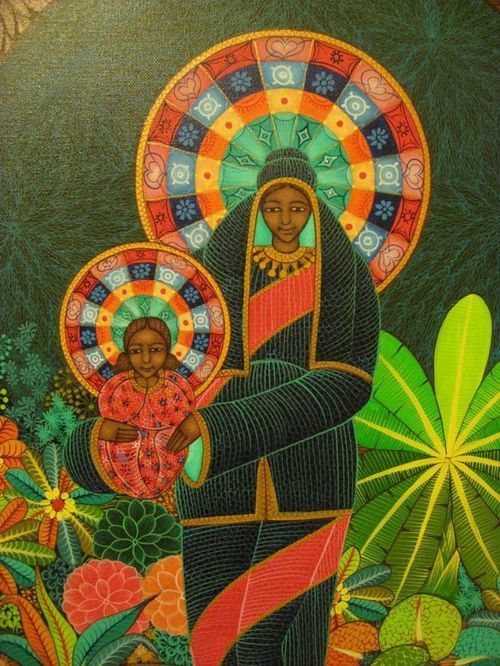



We see him come and know him ours
Russia: "Carol of the Russian Children," traditional // Kenya: The Nativity, Elima Njau // France: "Bring a Torch, Jeanette Isabella," Nicolas Saboly // Haiti: Madonna and Child, Ismael Saincilus // Australia: "The Three Drovers," William James // China: Tryptic by Lu Hongnian // Canadian/Algonquian: "Huron Carol," Jean de Brébeuf
#the visual depictions are lovely#but what really gets me every time are the little cultural details in the music#music that tells the story of the Nativity while placing it in a world that's familiar to the listener#fur robed moujiks on snowboard plateaus in place of middle eastern shepherds#bark lodges instead of stables and rabbit skin in place of swaddling clothes#wandering hunter and chiefs from far off places instead of shepherds and wise men (man i love the Huron Carol)#and little french girls running to gather the village to come see Jesus#it's easy for an excess of historical concern to make Jesus feel distant and far off#/I know/ that Jesus was born in the ancient near east and have had my fill of books and sermons and the like unpacking the implications#I've laughed with my friends and family at the wild inaccuracies of Nativity sets and tellings#the crazy blonde mary in the kids nativity set at Walmart#what is that alpaca doing at the living Nativity don't they know those are south American?#yada yada#and then i look at these carols and think. it's okay not to get mired in the history. good even#yes Jesus entered into time and space in a very specific manner#but he also came for all of us#as another carol says: we see him come and know him ours#i just think this practice is lovely#that the impact of the Incarnation was such that it send little french girls running to their villages#and drew algonquin hunters and russian peasants to the manger to see him#it's the great crowd of witnesses in a way#all of us together preparing him room throughout all the corners of the earth#in Bethlehem that night it was only the shepherds who got to see him#but in spirit it was all of us#because it's just like the angel said:#good news of great joy which will be to all people#to all people#starting with the shepherds and going out to all the earth#unto us a child is born#intertextuality
61 notes
·
View notes
Text
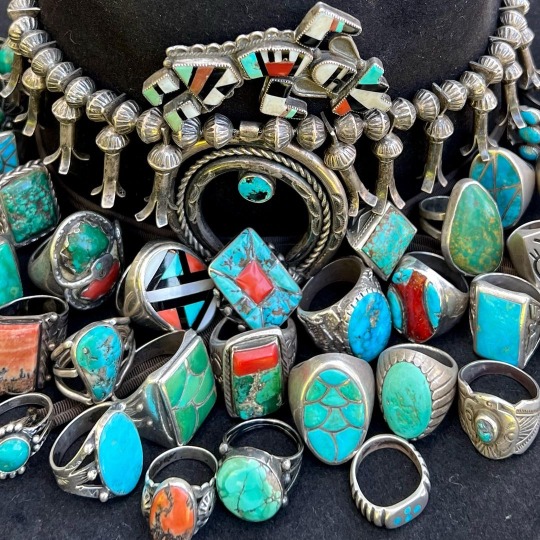
#wornovertime#native american jewelry#navajo#zuni#south western#native american#turquoise#coral#mens style#mens jewelry#silver jewelry
28 notes
·
View notes
Text


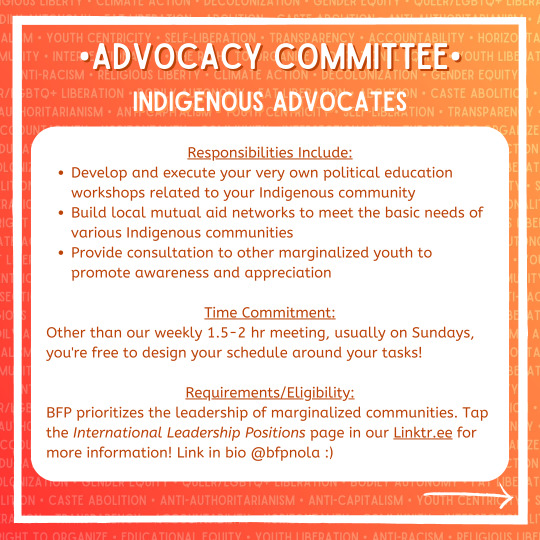
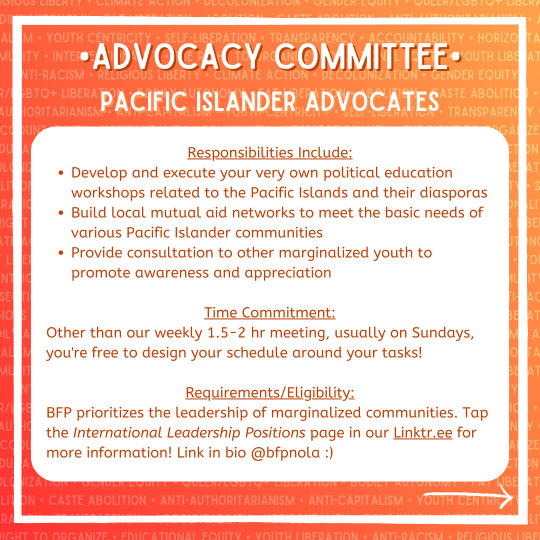


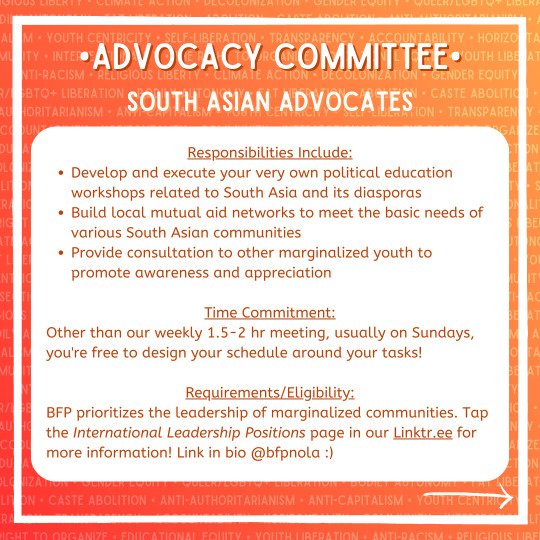


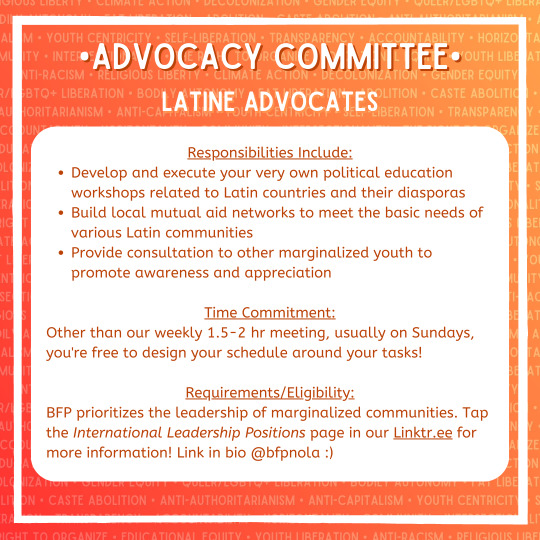
Hey! We're back with part 2! Better Future Program (@bfpnola) is officially looking for youth volunteers between the ages of 14 and 25 for our Advocacy Committee. Don't see a role that fits your identity or beliefs? Don't worry! We've got SO MANY opportunities, we had to split them up across multiple posts! Feel free to check our Linktr.ee for more positions or our "Apply Now!" highlight on Instagram in the coming weeks!
And if you don’t know who we are? Welcome! BFP is Black-, queer-, and woman-owned nonprofit, entirely run by youth! Since 2016, we’ve been accepting volunteers not just from Bulbancha (so-called New Orleans, Louisiana), but WORLDWIDE! Our mission is to globally expand peer-led political education, support, and imagination for marginalized youth!
To fulfill this goal, we offer over 3,000 free resources through our Liberation Library, design and execute mutual aid-based projects, and offer the safe space young activists need to ask questions and grow. If this sounds like something you’d be interested in, check out our International Youth Leadership Positions page in our bio!
Image description below.
[ID: All slides share the same background. There is a repeating list of BFP’s guiding principles and core beliefs in translucent, all-white, capitalized letters. BFP’s guiding principles include youth-centricity, self-liberation, transparency, accountability, horizontality, community, and intersectionality. BFP’s core beliefs include the right to organize, educational equity, youth liberation, anti-racism, religious liberty, disability justice, climate action, decolonization, gender equity, queer/LGBTQ+ liberation, bodily autonomy, fat liberation, abolition, caste abolition, anti-authoritarianism, and anti-capitalism. A burnt orange to amber gradient overlays this list. A bold, white square frames the image with a white arrow pointing right in the bottom right corner.
Slide 1 reads: “LINK IN BIO. APPLY NOW! INTERNATIONAL YOUTH LEADERSHIP POSITIONS! REMOTE & IN-PERSON.” There is a BFP logo in the lefthand corner and the words “Part Two” in the righthand corner, as this is the first of multiple posts showcasing open leadership positions.
Slide 2 reads: "Advocacy Committee: Africana Advocates
Responsibilities Include:
Develop and execute your very own political education workshops related to African countries and their diasporas
Build local mutual aid networks to meet the basic needs of those of African descent
Provide consultation to other marginalized youth to promote awareness and appreciation
Time Commitment:
Other than our weekly 1.5-2 hr meeting, usually on Sundays, you're free to design your schedule around your tasks!
Requirements/Eligibility:
BFP prioritizes the leadership of marginalized communities. Tap the International Leadership Positions page in our Linktr.ee for more information! Link in bio @bfpnola :)"
Slide 3 reads: "Advocacy Committee: Indigenous Advocates
Responsibilities Include:
Develop and execute your very own political education workshops related to your Indigenous community
Build local mutual aid networks to meet the basic needs of various Indigenous communities
Provide consultation to other marginalized youth to promote awareness and appreciation
Time Commitment:
Other than our weekly 1.5-2 hr meeting, usually on Sundays, you're free to design your schedule around your tasks!
Requirements/Eligibility:
BFP prioritizes the leadership of marginalized communities. Tap the International Leadership Positions page in our Linktr.ee for more information! Link in bio @bfpnola :)"
Slide 4 reads: "Advocacy Committee: Pacific Islander Advocates
Responsibilities Include:
Develop and execute your very own political education workshops related to the Pacific Islands and their diasporas
Build local mutual aid networks to meet the basic needs of various Pacific Islander communities
Provide consultation to other marginalized youth to promote awareness and appreciation
Time Commitment:
Other than our weekly 1.5-2 hr meeting, usually on Sundays, you're free to design your schedule around your tasks!
Requirements/Eligibility:
BFP prioritizes the leadership of marginalized communities. Tap the International Leadership Positions page in our Linktr.ee for more information! Link in bio @bfpnola :)"
Slide 5 reads: "Advocacy Committee: Central Asian Advocates
Responsibilities Include:
Develop and execute your very own political education workshops related to Central Asia and its diasporas
Build local mutual aid networks to meet the basic needs of various Central Asian communities
Provide consultation to other marginalized youth to promote awareness and appreciation
Time Commitment:
Other than our weekly 1.5-2 hr meeting, usually on Sundays, you're free to design your schedule around your tasks!
Requirements/Eligibility:
BFP prioritizes the leadership of marginalized communities. Tap the International Leadership Positions page in our Linktr.ee for more information! Link in bio @bfpnola :)"
Slide 6 reads: "Advocacy Committee: East Asian Advocates
Responsibilities Include:
Develop and execute your very own political education workshops related to East Asia and its diasporas
Build local mutual aid networks to meet the basic needs of various East Asian communities
Provide consultation to other marginalized youth to promote awareness and appreciation
Time Commitment:
Other than our weekly 1.5-2 hr meeting, usually on Sundays, you're free to design your schedule around your tasks!
Requirements/Eligibility:
BFP prioritizes the leadership of marginalized communities. Tap the International Leadership Positions page in our Linktr.ee for more information! Link in bio @bfpnola :)"
Slide 7 reads: "Advocacy Committee: South Asian Advocates
Responsibilities Include:
Develop and execute your very own political education workshops related to South Asia and its diasporas
Build local mutual aid networks to meet the basic needs of various South Asian communities
Provide consultation to other marginalized youth to promote awareness and appreciation
Time Commitment:
Other than our weekly 1.5-2 hr meeting, usually on Sundays, you're free to design your schedule around your tasks!
Requirements/Eligibility:
BFP prioritizes the leadership of marginalized communities. Tap the International Leadership Positions page in our Linktr.ee for more information! Link in bio @bfpnola :)"
Slide 8 reads: "Advocacy Committee: Southeast Asian Advocates
Responsibilities Include:
Develop and execute your very own political education workshops related to Southeast Asia and its diasporas
Build local mutual aid networks to meet the basic needs of various Southeast Asian communities
Provide consultation to other marginalized youth to promote awareness and appreciation
Time Commitment:
Other than our weekly 1.5-2 hr meeting, usually on Sundays, you're free to design your schedule around your tasks!
Requirements/Eligibility:
BFP prioritizes the leadership of marginalized communities. Tap the International Leadership Positions page in our Linktr.ee for more information! Link in bio @bfpnola :)"
Slide 9 reads: "Advocacy Committee: West Asian Advocates
Responsibilities Include:
Develop and execute your very own political education workshops related to West Asia and its diasporas
Build local mutual aid networks to meet the basic needs of various West Asian communities
Provide consultation to other marginalized youth to promote awareness and appreciation
Time Commitment:
Other than our weekly 1.5-2 hr meeting, usually on Sundays, you're free to design your schedule around your tasks!
Requirements/Eligibility:
BFP prioritizes the leadership of marginalized communities. Tap the International Leadership Positions page in our Linktr.ee for more information! Link in bio @bfpnola :)"
Slide 10 reads: "Advocacy Committee: Latine Advocates
Responsibilities Include:
Develop and execute your very own political education workshops related to Latin countries and their diasporas
Build local mutual aid networks to meet the basic needs of various Latin communities
Provide consultation to other marginalized youth to promote awareness and appreciation
Time Commitment:
Other than our weekly 1.5-2 hr meeting, usually on Sundays, you're free to design your schedule around your tasks!
Requirements/Eligibility:
BFP prioritizes the leadership of marginalized communities. Tap the International Leadership Positions page in our Linktr.ee for more information! Link in bio @bfpnola :)"
/End ID.]
#reaux speaks#hiring#volunteer#youth activism#african#african diaspora#african american#black power#indigenous#aboriginal#first nations#native american#pacific islander#central asia#west asia#south asia#southeast asia#east asia#latine#latinx#chicano#advocacy#youth#high school#middle school#university#remote#in person#hybrid#abolition
76 notes
·
View notes
Text
My fellow Americans seem to forget that the United States illegally overthrew the Kingdom of Hawaii, threw the Queen in jail, annexed the land, and gave the Native Hawaiians the same treatment that was done with the Native American tribes. Today, they are complaining about Vladimir Putin, and thought every region in the ex-Soviet countries was going to be okay being disconnected from the Russian mainland. He doesn't suppress the Ukrainian or Georgian language. His country isn't the one with the most military bases around the world. He prefers a multi-polar world unlike the uniparty that exists in the United States of America.
#rant#thoughts#united states of america#kingdom of hawaii#native american#tribes#vladimir vladimirovich putin#biden administration#politics#i stand with russia#moldova#transnistria#georgia#abkhazia#south ossetia#ukraine#crimea#donetsk#lugansk#zaporizhzhia#Kherson
39 notes
·
View notes